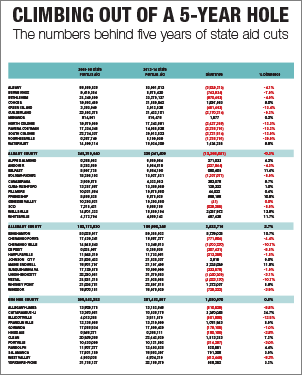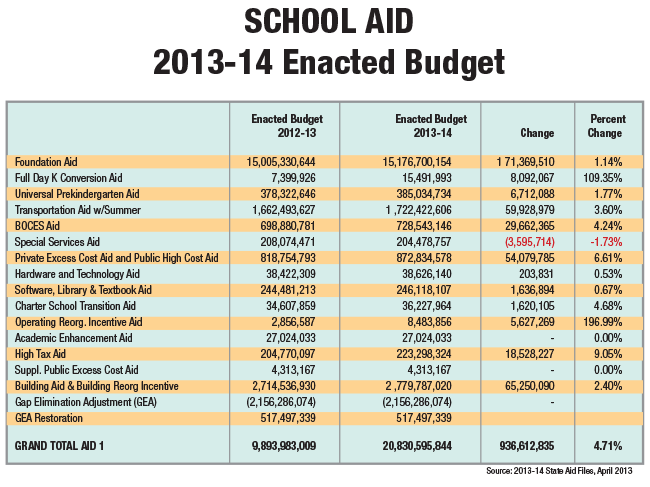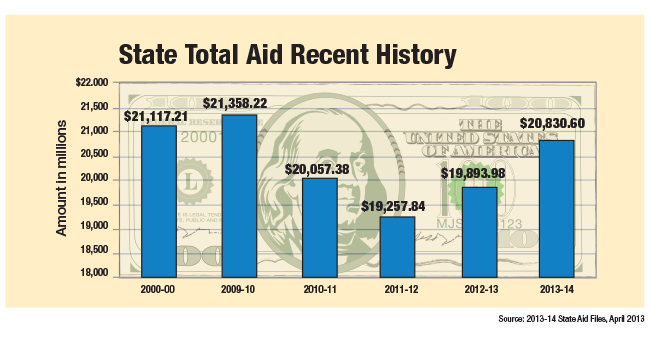Public schools lost $2 billion just to inflation; analysis shows who got hit hardest
 ALBANY, N.Y. January 23, 2014 - State support for public education dropped to its lowest levels since the late 1940s over the past two years and, under the executive budget proposed this week, 69 percent of the state's 672 school districts would begin the 2014-15 school year with less state aid than in 2009-10, a new analysis by New York State United Teachers showed today.
ALBANY, N.Y. January 23, 2014 - State support for public education dropped to its lowest levels since the late 1940s over the past two years and, under the executive budget proposed this week, 69 percent of the state's 672 school districts would begin the 2014-15 school year with less state aid than in 2009-10, a new analysis by New York State United Teachers showed today.
In addition, the proposed education budget's $602.8 million total school aid increase would leave 418 school districts, or 62 percent, with less state aid than in 2008-09 - six years ago.
Overall, state aid to local school districts is proposed at $21.28 billion for 2014-15, below the 2009-10 level of $21.35 billion and just above the $21.1 billion in funding for schools in 2008-09. The analysis of state budget cuts on schools also shows that had New York merely increased state aid by the rate of inflation over five years, districts would have $2 billion more to support students and programs than they have today.
"The raw numbers tell a story of pain that is playing out in virtually every community. While last year's budget began to slowly address the massive cuts suffered during the recent fiscal crisis and we are heartened by strong support from legislators for a substantial education budget increase in 2014-15, years of devastating budget cuts, combined with an inequitable and undemocratic tax cap, have taken a severe toll on public schools. We need to restore the programs and services our students need, and invest in the dedicated and skilled professionals who deliver those services in our classrooms," said NYSUT President Richard C. Iannuzzi.
Iannuzzi noted the state continues to fail to fund the Campaign for Fiscal Equity settlement or even account for inflation. Yet, the executive budget proposal contains 'feel good' tax cuts that rob the state of the revenues it needs to support education, pre-K through post graduate, and other public services. Iannuzzi said, "Tax cuts for the wealthy that will widen the wealth gap and, as a result, widen the achievement gap, are unacceptable. This is the year Albany must make a bold investment in public education, and do so equitably. Our most vulnerable students must not be disadvantaged.
NYSUT's analysis buttresses its and the Alliance for Quality Education's push for a $1.9 billion school aid increase in the upcoming state budget and dovetails with an Educational Conference Board report that said school districts would need a $1.5 billion state funding increase just to maintain current programs and services. The New York State Council of School Superintendents recently said that 40 districts report they would face fiscal insolvency within two years. And, state Comptroller Thomas DiNapoli noted in a January 14 report that 87 districts are facing fiscal stress, adding state aid in 2011-12 was $8 billion lower than what had been projected by the state in 2008-09.
"Legislators are clearly hearing the outcry from parents and education leaders in their home districts. We are encouraged that more than 80 legislators signed a letter backing our support for a $1.9 billion increase in the coming budget," said NYSUT Executive Vice President Andrew Pallotta. "To begin to repair the damage wrought by painful budget cuts, every dollar possible must be funneled into New York's classrooms to help schools dig out from this fiscal mess and make the real investments that students and teachers need."
NYSUT's analysis shows districts in every corner of the state are struggling with less state aid than in 2008-09, and that total state support to schools - at 34.1 percent of total education spending in 2011-12 and an estimated 34.9 percent in 2012-13 – is the lowest since 1948, when Harry S. Truman defeated Republican New York Gov. Thomas Dewey to win the White House
Based on current funding levels, the Albany School District is still 4.1 percent, or $3.6 million, below its state aid level of five years ago, while Kinderhook in Colombia County struggles with 18.7 percent, or $2.7 million, less. Liverpool in Central New York is operating with 14.1 percent, or $8.35 million, less in state aid than in 2008-09, while Vestal in the Southern Tier is constrained by state aid that is 10.7 percent, or $2.6 million, less than five years ago. State aid to Jamestown is 5.1 percent, or $2.9 million, less than 2008-09, while Smithtown in Suffolk County is $6.6 million, or 14.4 percent, below the state aid it received five years ago. Mount Vernon in Westchester County is receiving $7.5 million, or 9.3 percent, less in state aid than in 2008-09, while Fairport in Monroe County has made drastic program cuts to adjust for 9.8 percent, or $3.4 million, less in state aid compared to five years ago.
Among the counties, state funding for Suffolk County schools is $60.5 million - and Nassau County $19.1 million - below where it was in 2008-09. State support for Albany County school districts is 5.3 percent, or $13.3 million, less than five years ago. Districts in other counties, including Rockland (4.4 percent, $8.5 million); Onondaga (2.6 percent; $16.2 million) and Dutchess (5.5 percent, $14.9 million), are seeing large net losses in state aid compared to 2008-09.
In the Big 5 districts, Yonkers is receiving $2.2 million less than five years ago; New York City is $58.7 million below 2008-09, while state aid to Buffalo, Syracuse and Rochester has failed to keep up with student needs. A breakdown by county and individual school district is attached and available at www.nysut.org
NYSUT pointed out that the enacted school aid formula was $21.1 billion for 2008-09, about $300 million more in real dollars than this current year's total of $20.8 billion. With total inflation at 8 percent over the last five years, school aid this year would have been $22.8 billion had state support from Albany merely kept pace with inflation. Instead, it is $2 billion below that figure.
New York State United Teachers is a statewide union with more than 600,000 members. Members are pre-K-12 teachers; school-related professionals; higher education faculty; other professionals in education, human services and health care; and retirees. NYSUT is affiliated with the American Federation of Teachers, the National Education Association and the AFL-CIO.

